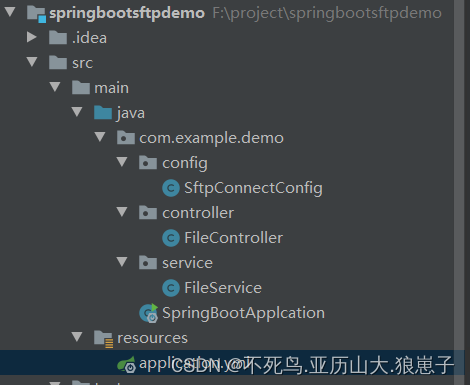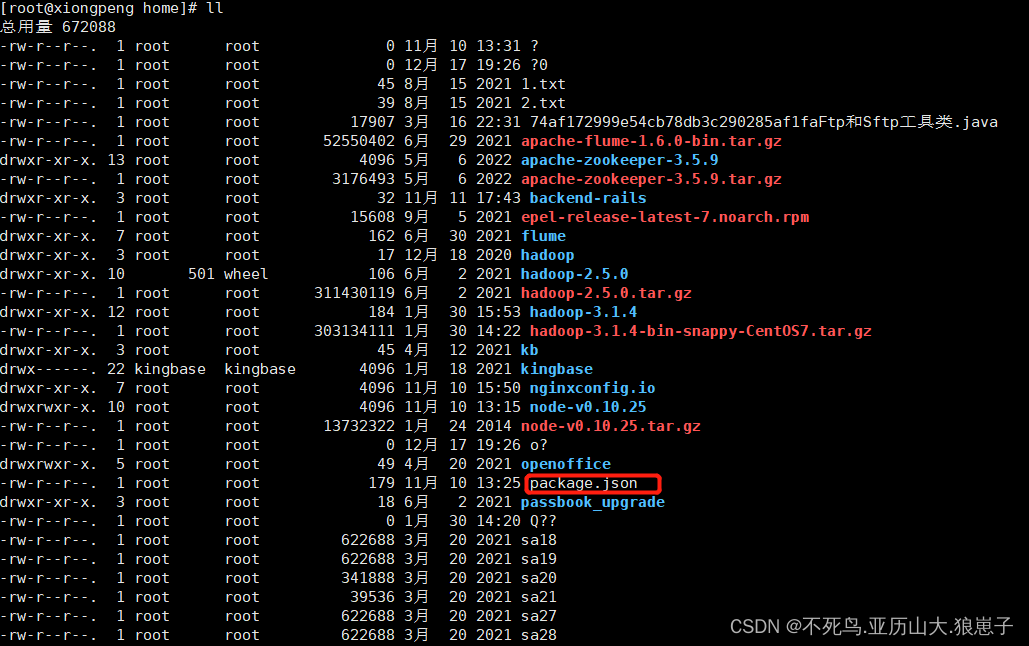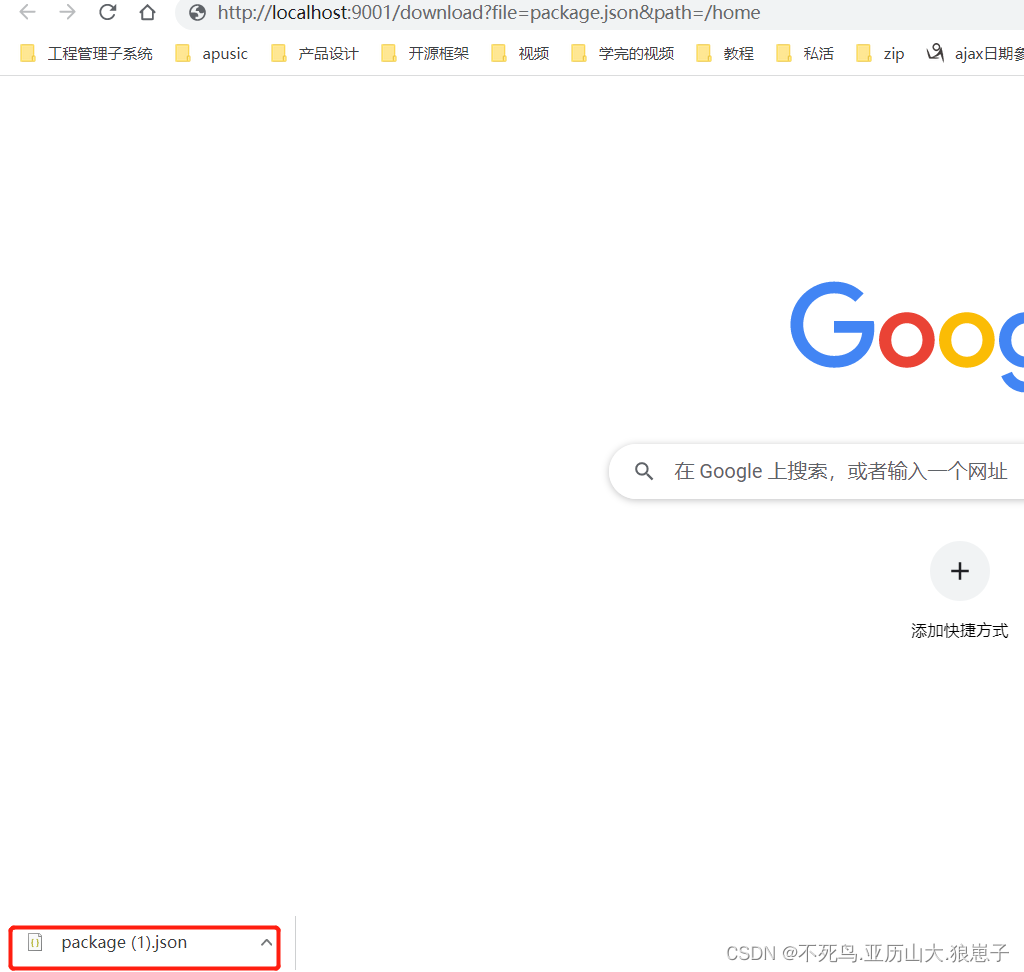之前项目遇到从文件服务器上传、下载、删除文件,一开始打算使用一些高级的文件系统,比如:FastDFS,GlusterFS,CephFS,这些高级厉害的文件存储系统,但是由于环境限制无法搭建,最终使用常用的FFTP或者SFTP实现文件上传和下载。
FTP是一种文件传输协议,一般是为了方便数据共享的。包括一个FTP服务器和多个FTP客户端。FTP客户端通过FTP协议在服务器上下载资源。而SFTP协议是在FTP的基础上对数据进行加密,使得传输的数据相对来说更安全。但是这种安全是以牺牲效率为代价的,也就是说SFTP的传输效率比FTP要低(不过现实使用当中,没有发现多大差别)。
(1)FTP要安装,SFTP不要安装。
(2)SFTP更安全,但更安全带来副作用就是的效率比FTP要低些。所以最终还是采用了SFTP来实现。
1 新建springboot项目

2 引入pom文件依赖包
<?xml version="1.0" encoding="UTF-8"?>
<project xmlns="http://maven.apache.org/POM/4.0.0" xmlns:xsi="http://www.w3.org/2001/XMLSchema-instance"
xsi:schemaLocation="http://maven.apache.org/POM/4.0.0 https://maven.apache.org/xsd/maven-4.0.0.xsd">
<modelVersion>4.0.0</modelVersion>
<parent>
<groupId>org.springframework.boot</groupId>
<artifactId>spring-boot-starter-parent</artifactId>
<version>2.7.9</version>
<relativePath/> <!-- lookup parent from repository -->
</parent>
<groupId>com.example</groupId>
<artifactId>demo</artifactId>
<version>0.0.1-SNAPSHOT</version>
<name>demo</name>
<description>Demo project for Spring Boot</description>
<properties>
<java.version>1.8</java.version>
</properties>
<dependencies>
<dependency>
<groupId>org.springframework.boot</groupId>
<artifactId>spring-boot-starter-web</artifactId>
</dependency>
<dependency>
<groupId>org.springframework.boot</groupId>
<artifactId>spring-boot-starter</artifactId>
</dependency>
<!--sftp核心依赖包-->
<dependency>
<groupId>com.jcraft</groupId>
<artifactId>jsch</artifactId>
<version>0.1.54</version>
</dependency>
<dependency>
<groupId>org.apache.commons</groupId>
<artifactId>commons-lang3</artifactId>
</dependency>
<dependency>
<groupId>commons-io</groupId>
<artifactId>commons-io</artifactId>
<version>2.4</version>
</dependency>
<dependency>
<groupId>org.projectlombok</groupId>
<artifactId>lombok</artifactId>
<version>1.18.12</version>
<scope>provided</scope>
</dependency>
<dependency>
<groupId>org.springframework.boot</groupId>
<artifactId>spring-boot-starter-test</artifactId>
<scope>test</scope>
</dependency>
</dependencies>
<build>
<plugins>
<plugin>
<groupId>org.springframework.boot</groupId>
<artifactId>spring-boot-maven-plugin</artifactId>
</plugin>
</plugins>
</build>
</project>
3 新建配置文件
server:
port: 9001
spring:
application:
name: study_sftp_service
servlet:
multipart:
# 单个文件的大小不能超过该值
max-file-size: 100MB
# 单个请求最大的大小不能超过该值
max-request-size: 1000MB
# 这里也可以直接作为成员变量写死在类里。这里的配置都是我自定义的,叫什么都可以。
remoteserver:
username: root
password: 123456
host: 192.168.222.131
port: 224 编写配置类
注意:JSch登录sftp会进行Kerberos username 身份验证提示
如果需要跳过,需要添加配置如下:
config.put("PreferredAuthentications","publickey,keyboard-interactive,password");
package com.example.demo.config;
import com.jcraft.jsch.*;
import lombok.extern.slf4j.Slf4j;
import org.springframework.beans.factory.annotation.Value;
import org.springframework.context.annotation.Bean;
import org.springframework.context.annotation.Configuration;
import java.util.Properties;
@Configuration
@Slf4j
public class SftpConnectConfig {
/**
* FTP 登录用户名
*/
@Value("${remoteserver.username}")
private String username;
/**
* FTP 登录密码
*/
@Value("${remoteserver.password}")
private String password;
/**
* FTP 服务器地址IP地址
*/
@Value("${remoteserver.host}")
private String host;
/**
* FTP 端口
*/
@Value("${remoteserver.port}")
private String strPort;
private Session getSession() throws JSchException {
JSch jsch = new JSch();
int port = Integer.parseInt(strPort.trim());
Session session = jsch.getSession(username, host, port);
if (password != null) {
session.setPassword(password);
}
Properties config = new Properties();
config.put("StrictHostKeyChecking", "no");
// JSch登录sftp,跳过 Kerberos username 身份验证提示
config.put("PreferredAuthentications","publickey,keyboard-interactive,password");
session.setConfig(config);
session.connect();
return session;
}
/**
* 连接sftp服务器,返回的是sftp连接通道,用来操纵文件
* @throws Exception
*/
@Bean
public ChannelSftp channelSftp() {
ChannelSftp sftp = null;
try {
Session session = getSession();
Channel channel = session.openChannel("sftp");
channel.connect();
sftp = (ChannelSftp) channel;
} catch (JSchException e) {
log.error("连接失败",e);
}
return sftp;
}
/**
* 连接sftp服务器,返回exec连接通道,可以远程执行命令
* @throws Exception
*/
@Bean
public ChannelExec channelExec(){
ChannelExec sftp = null;
try {
Session session = getSession();
Channel channel = null;
channel = session.openChannel("exec");
channel.connect();
sftp = (ChannelExec) channel;
} catch (JSchException e) {
log.error("连接失败",e);
System.out.println("连接失败");
}
return sftp;
}
}
5 编写service
package com.example.demo.service;
import com.jcraft.jsch.ChannelSftp;
import lombok.extern.slf4j.Slf4j;
import org.apache.commons.io.FileUtils;
import org.apache.commons.io.IOUtils;
import org.springframework.stereotype.Service;
import org.springframework.web.multipart.MultipartFile;
import javax.annotation.Resource;
import java.io.File;
import java.io.FileInputStream;
import java.io.InputStream;
import java.util.UUID;
@Service
@Slf4j
public class FileService {
@Resource
private ChannelSftp channelSftp;
/**
* 从服务器获取文件并返回字节数组
* @param path 要下载文件的路径
* @param file 要下载的文件
*/
public byte[] download(String path, String file) throws Exception {
// 切换到文件所在目录
channelSftp.cd(path);
//获取文件并返回给输入流,若文件不存在该方法会抛出常
InputStream is = channelSftp.get(file);
byte[] fileData = IOUtils.toByteArray(is);
if(is != null){
is.close();
}
return fileData;
}
/**
* 将输入流的数据上传到sftp作为文件
*
* @param path
* 上传到该目录
* @param uploadFile
* 服务器保存的文件
* @throws Exception
*/
public void upload(MultipartFile uploadFile, String path) throws Exception{
String fileName = uploadFile.getOriginalFilename();
// 用uuid + 原来的文件名生成新名字,防止文件名重复也可以辨识上传的文件是哪个,可以省略这一步
String newName = UUID.randomUUID().toString().replaceAll("-","") + fileName;
File file = new File(path + newName);
//将MultipartFilez转换为File,会生成文件
FileUtils.copyInputStreamToFile(uploadFile.getInputStream(), file);
// 如果该目录不存在则直接创建新的目录,并切换到该目录
try {
channelSftp.cd(path);
} catch (Exception e) {
channelSftp.mkdir(path);
channelSftp.cd(path);
}
channelSftp.put(new FileInputStream(file), newName);
// 操作完成,删除刚刚生成的文件
file.delete();
}
}6 编写控制器
package com.example.demo.controller;
import com.example.demo.service.FileService;
import lombok.extern.slf4j.Slf4j;
import org.springframework.beans.factory.annotation.Autowired;
import org.springframework.web.bind.annotation.*;
import org.springframework.web.multipart.MultipartFile;
import javax.servlet.http.HttpServletResponse;
import java.io.OutputStream;
@RestController
@Slf4j
public class FileController {
@Autowired
private FileService fileService;
@GetMapping("/download")
public void download(@RequestParam(required = true) String file, @RequestParam(required = true)String path,
HttpServletResponse response){
//设置响应信息
response.setContentType("application/octet-stream");
// filename为文件下载后保存的文件名,可自行设置,但是注意文件名后缀,要和原来的保持一致
response.setHeader("Content-Disposition", "attachment; filename=" + file);
OutputStream out = null;
try {
out = response.getOutputStream();
// 输出到客户端
out.write(fileService.download(path, file));
} catch (Exception e) {
log.error("",e);
}
}
/**
* 上传文件到服务器
* @param file 要上传到服务器的文件,注意此处的path必须在结尾添加 /
* @param path 上传到服务器的路径
*/
@PostMapping("/upload")
public void upload(@RequestBody(required = true) MultipartFile file, @RequestParam(required = true) String path){
try {
fileService.upload(file, path);
} catch (Exception e) {
log.error("",e);
}
}
}
7 测试
7.1 文件下载
下载home目录下的package.json文件

访问端口如下:
http://localhost:9001/download?file=package.json&path=/home

7.2 上传文件
端口参数为file文件和path上传的文件路径

查看目录返现上传成功(注意:文件名不要有中文)
